From a cinematic standpoint 1996 can be viewed as the beginning of the end on two counts. First, it was in ‘96 that the independent film revolution of the first half of the decade began to sour, with the costly Sundance acquisitions of HAPPY TEXAS and THE SPITFIRE GRILL, both of which tanked miserably. Second, ‘96 can be marked the final year of traditional film exhibition before digital video became a real factor. It was in ’97, after all, that the first digitally shot feature (Frank Grow’s LOVE GOD) appeared, and while it took DV several more years to fully come into prominence, the writing, as they say, was definitely on the wall.
1996, it turns out, was also quite rich in the type of obscure but worthy films that tend to comprise my Year in Bedlam listings. The big movies of the year—INDEPENDENCE DAY, TWISTER, THE ROCK, 101 DALMATIONS, ERASER—certainly didn’t offer much in the way of competition for the 30 lesser known gems listed below, which all deserve to be sought out and enjoyed.
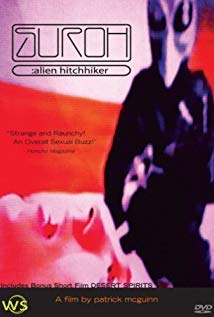 30. SUROH: ALIEN HITCHHIKER
30. SUROH: ALIEN HITCHHIKER
There’s really not much to this SOV oddity, but I got a kick out of it. The second film by Patrick McGuinn (of DESERT SPIRITS non-fame), it features a crash-landed alien (actually a dude in a bulky jumpsuit and bug eyed mask) mind-melding with a young slacker, who subsequently decides he’s in love. That’s about all there is to this flick, which is distinguished by a wholly outrageous sequence wherein the slacker and the alien have sex (of a sort), involving a riot of stock footage intercuts, video effects and the lead actor (Peter Gingerich) writhing naked on his bed.
29. THE BLOODY CHILD
I was first alerted to this Nina Menkes film in a movie line by a 1996 Sundance attendee, who claimed THE BLOODY CHILD was the ‘96 Sundance film that “nobody was seeing.” I can understand why: it’s a severely affected and downright obnoxious ramble that was allegedly inspired by a real incident involving a Marine who murdered his wife in the Mojave Desert. Not that you’d be able to tell from watching this film, which in place of a traditional narrative circles back and forth endlessly between the scene of the arrest, the killer in his hotel room the night before and the murdered woman, who lies in an indistinct tropical landscape (heaven?) reciting nonsensical poetry. You can make of all this what you will (it’s supposedly meant to evoke the toxic nature of male aggression, or something), but it does have a profoundly haunting resonance. It’s the only Menkes film I’ve seen that has drawn me back for multiple viewings, so clearly there’s something to it.
28. IRMA VEP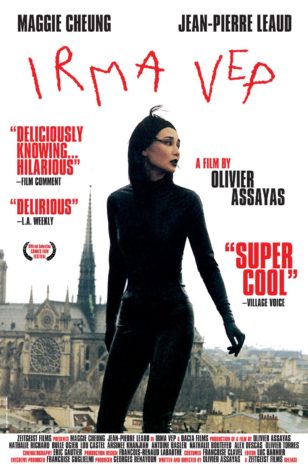
This breezy French film isn’t the masterpiece many critics made it out to be, but it is a wholly unique, intriguingly self-reflective look at the moviemaking process. Hong Kong starlet Maggie Cheung plays herself, toiling on a severely misguided remake of the classic Louis Feuillade serial LES VAMPIRES. The director, played by Jean-Pierre Leaud, is having a nervous breakdown, and the production is afflicted by infighting. The slim and athletic Cheung, playing the black latex-clad seductress Irma Vep, gets a bit overly absorbed in her role, acting it out in “real” life by stealing a cache of diamonds from a hotel room. There’s also a bisexual crewwoman with a crush on Cheung and a pompous AD with whom she gets into an argument about popular versus personal moviemaking. The whole thing has an appealingly loose, rock ‘n’ roll vibe, with invigorating handheld camerawork and a refreshing sense of playfulness. It is, in a word, cool.
27. CURDLED
This black comedy, adapted form a well-received 1991 student short, was executive produced by Quentin Tarantino and stars the shamefully underrated Angela Jones (the Latina cab driver from PULP FICTION). She plays a death-obsessed Columbian woman who takes a job cleaning up crime scenes. William Baldwin plays a good looking serial killer whose latest victim just happens to reside in the house Ms. Jones is currently cleaning. Director Reb Braddock uses his leading lady in much the same way Tarantino did, by contrasting her sunny good looks and childlike demeanor with an unhealthy streak of morbid curiosity. CURDLED overall follows suit, dealing with dark subject matter in a deceptively light-hearted manner, complete with a bouncy cha-cha score and a bright, cheery color scheme. The film bears many of the pratfalls common to feature films adapted from shorts (a lot of noticeable padding first and foremost), but it works, being essentially a warped character study, and a compelling one.
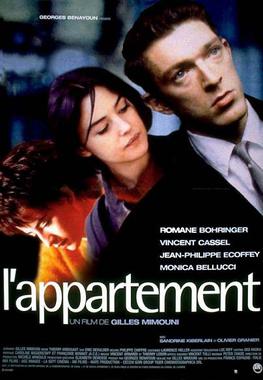 26. THE APARTMENT (L’APPARTEMENT)
26. THE APARTMENT (L’APPARTEMENT)
No, this French quasi-thriller is not a perfect film, but it is a slick, hyper-stylish Brian DePalma-esque piece of work. It pivots on a man (Vincent Cassel) who spots his flighty ex (Monica Bellucci) one day, and decides to put his life on hold to stalk her. This sets in motion a warped romantic quadrangle, with Cassel becoming involved with Bellucci’s lookalike friend (Romane Bohringer), who it just so happens is romancing Cassel’s best friend (Jean-Phillippe Ecoffey). We learn all this through a complex narrative that freely juggles past and present, often replaying events from different perspectives to show that what we thought was happening wasn’t. It’s often exasperating, but always fascinating and never predictable—plus Bellucci back in ‘96 was near-inhumanly gorgeous.
25. THE FUNERAL
One of Abel Ferrara’s quickie productions from the nineties, and one of the most interesting of them. A mob drama set in the thirties, the film moves really slowly and contains an unusually high ratio of violence and sleaze—it is, in other words, vintage Ferrara. It features Christopher Walken, Chris Penn and Benicio Del Toro as brothers in a mob family whose youngest sibling, played by Vincent Gallo, has just been killed. All are forced to face up to the amoral life they’ve chosen, with explosive—or at least incendiary—results. This is among Ferrara’s most subdued works, but it’s still packed with blood and sex aplenty, as well as a restless intelligence and a doom-laden atmosphere so vivid it can (pardon the cliché) be cut with a knife—or, perhaps more appropriately, a gun.
24. MY MAN (MON HOMME)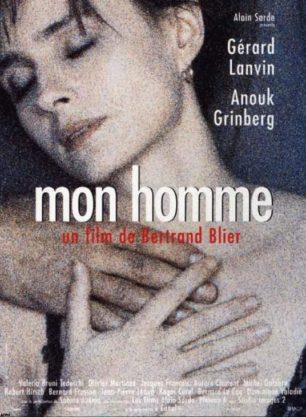
This surreal sex comedy by the veteran French society-basher Bertrand Blier was something of a return to form after the decidedly uncharacteristic likes of MERCI LA VIE and 1, 2, 3, FREEZE. MY MAN is an outrageous farce about a prostitute (Anouk Grinberg), her newfound pimp—a bum (Gerard Lanvin) with a sweet cock—and his debauched clientele. The constantly mutating storyline never takes an expected turn, and Blier has quite a few pertinent points to make about the war of the sexes (the final line is a classic). It’s admittedly quite confounding at times trying to figure out whether the film is satirizing sexist attitudes or propagating them—which, I imagine, is precisely how Blier wants us to feel.
23. THE EMPEROR’S SHADOW (QIN SONG)
An epic film with all the trimmings, and an interesting bookend to THE LAST EMPEROR. THE EMPEROR’S SHADOW, by contrast, is about China’s first emperor (Wen Jiang) and his fraught relationship with a childhood colleague (You Ge), now the country’s greatest musician, who’s delivered into the emperor’s clutches after the latter’s armies conquer his home state. The emperor orders his old friend to compose music for him, which leads to a series of complications involving the emperor’s fetching daughter (Qing Xu), with whom You unwisely falls in love. In terms of pure spectacle this film is a masterpiece, with amazingly sumptuous period-specific sets, peopled with what look like thousands of extras and some excruciating, albeit realistic, depictions of torture and execution. Unfortunately, in common with countless other screen epics it’s somewhat lacking in the storytelling department, being dense and frequently hard to follow. I’ll also complain about the ridiculous slow-motion sex scenes, which are right out of RED SHOE DIARIES.
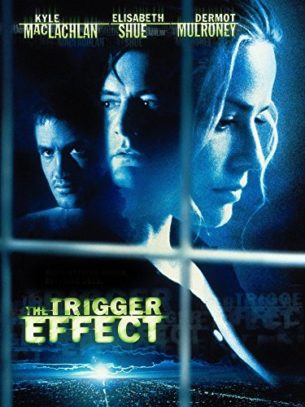 22. THE TRIGGER EFFECT
22. THE TRIGGER EFFECT
This film, about a massive blackout that brings out the worst in the residents of an American suburb, was completely ignored during its initial release. I feel that now, in the wake of 9/11 and several major hurricanes, THE TRIGGER EFFECT deserves a reappraisal. Elizabeth Shue and Kyle MacLachlan play a suburban couple caught up in the blackout, which sets off a wave of looting and violence. THE TRIGGER EFFECT will never be mistaken for Hitchcock, but in this, his first directorial outing, JURASSIC PARK screenwriter David Koepp has created a gripping and suspenseful film with a reasonably strong sense of realism. The film’s many Hollywood-ish elements—distracting backlighting, overlit “night” shots, a forced happy ending—were probably inevitable given Koepp’s big studio pedigree, and keep the proceedings from greatness. Another problem is that for all its effectiveness the film fails to maintain the impeccably crafted sense of tension and coiled menace of its opening scene, set in a movie theater (the late Hollywood Galaxy multiplex) before the power goes out.
21. EBOLA SYNDROME (YI BOH LAI BENG DUK)
We all knew this was coming: a completely over-the-top horror-exploitation movie about the Ebola virus! It involves a psychopath hiding out in South Africa who contracts Ebola, and spreads it via some specially made human flesh hamburgers. Director Herman Yau makes his intentions clear early on: the opening twenty minutes contain lurid depictions of sex, murder, mass brutality, child abuse, urination, vomiting and masturbation, not to mention some truly ugly depictions of the type of casual racism that marked the apartheid era in South Africa (adding to the madness is the subtitled translation of the opening line of dialogue, involving a mother telling her kid to “go play with yourself”). In classic Hong Kong movie fashion the film is extremely kinetic, with ultra-fast pacing and performances that border on histrionic. One thing, however, that EBOLA SYNDROME definitely isn’t is boring.
20. JUDE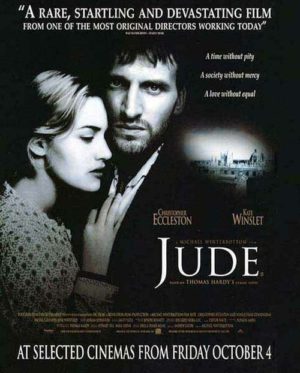
Michael Winterbottom is one of the most interesting directors at work today, but his films rarely ever reach their full potential. That’s true of this Thomas Hardy adaptation, although it is largely successful. The film’s presentation of eighteenth century England is vigorous and lively, avoiding the stuffiness of most historical movies—in fact it may be a bit too lively, with many distracting visual flourishes (swish pans, etc.). Christopher Eccleston is quite good as the title character, a hopeless loser who falls in love with his cousin (Kate Winslet). She’s initially frosty toward him but eventually gives in to his affections, leading to the couple being shunned by society and a truly appalling tragedy involving Jude’s inherited son from a previous marriage and two infants birthed by Winslet. The proceedings here are every bit as profoundly bleak as those of the novel, meaning that, if nothing else, this is an uncompromisingly faithful adaptation.
19. JOE’S APARTMENT
An engagingly ridiculous mid-nineties time capsule, JOE’S APARTMENT was the inaugural entry of MTV Films, and seemed pretty disposable in its day. It’s still disposable, but its core weirdness shines far more brightly now, if for no other reason than the fact that such a film could never, ever be made today. Jerry O’Connell stars as a dweeb who moves into a shithole NYC apartment building that is inhabited by talking and singing CGI cockroaches. The narrative was admittedly inspired by that of the Japanese oddity TWILIGHT OF THE COCKROACHES, but it lacks the intelligent social commentary of that pic. What we get in its place is a lot of singing, dancing and excess goofiness on the part of the roaches, voiced by cartoon voice-over legend Billy West and others, and also a dopey romance between O’Connell and Megan Ward as a fetching 911 operator. It’s all just as dumb as it sounds, but there’s a reason this film has become a cult mainstay in recent years, as it has many gruesomely fascinating sights that offset its nonsensicality.
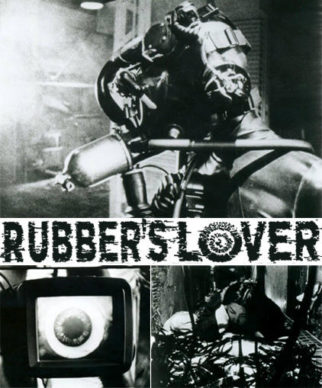 18. RUBBER’S LOVER
18. RUBBER’S LOVER
This black and white wonder was Japanese madman Shozin Fukui’s follow-up to his indescribably crazed 1991 “TETSUO on mescaline” pastiche PINOCCHIO 964—and frankly it’s a bit of a let-down. That’s not to say RUBBER’S LOVER is a non-worthwhile movie, however. Dealing, like PIONOCCHIO 964, with cyberpunk themes, it’s about an experiment into psychic potential that takes place in the claustrophobic confines of a dark warehouse. There a bunch of nutcases inject people with a dangerous drug and bombard them with loud noises. But when the experimenters unwisely kidnap an attractive young lady one of their subjects goes mad, unleashing a blast of gory mayhem that sees a woman graphically disemboweled, a guy puke his guts out and a lesbian literally devour her fuck mate. Despite all this, the film, unlike its predecessor, doesn’t really stand out amidst the avalanche of Japanese cyberpunk freak-outs like ORGAN, DEATH POWDER, TOKYO FIST, ELECTRIC DRAGON 800,000v, etc. Again, though, that doesn’t mean it’s a bad film. Far from it, as RUBBER’S LOVER adequately showcases its maker’s gift for crafting uniquely gruesome, disturbing imagery with an authentically demented edge. Watch it at your own risk!
17. NO WAY HOME
If you can forgive the low budget scuzziness that pervades this film (which isn’t helped at all by the lightening-up process present in nineties-era VHS releases), you’ll find a powerful and uncompromising depiction of urban angst as only writer-director Buddy Giovinazzo (of COMBAT SHOCK and LIFE IS HOT IN CRACKTOWN) can do it. The film is powered by expert performances from Tim Roth as an ex con, James Russo as his good-for-nothing brother and Deborah Kara Unger as the latter’s stripper wife, and further benefits from Giovinazzo’s sure grasp of character (the man, let’s not forget, is an accomplished novelist in addition to a filmmaker). This being a Buddy Giovinazzo movie, you can be sure that things will not turn out alright for any of these unfortunate folk, as tension amid the trio is evident from the start and only grows increasingly prevalent, leading to a profoundly dark, bloody ending that wouldn’t feel out of place in a slasher film.
16. 2 DAYS IN THE VALLEY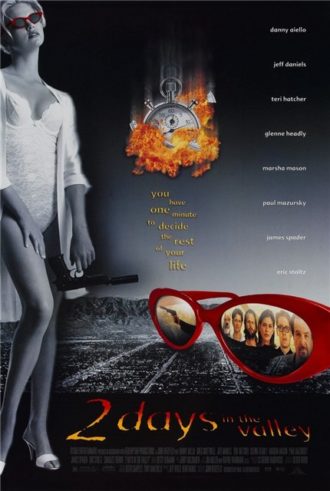
One of the better nineties-era Tarantino wannabes. Written and directed, unexpectedly enough, by John Herzfeld (of the legendary John Travolta-Olivia Newton John crapfest TWO OF A KIND and the nearly-as-awful Robert De Niro vehicle 15 MINUTES), 2 DAYS IN THE VALLEY is sprightly and imaginative, even if it hasn’t dated as well as it might have. The setting, as the title portends, is LA’s San Fernando Valley, where a charismatic hitman (James Spader) double-crosses and attempts to rub out one of his colleagues (Danny Aiello)—but the latter survives, and initiates an escalating series of complications involving a pair of bickering cops (Jeff Daniels and Eric Stoltz), an Olympic gymnast (Teri Hatcher), a rich asshole (Greg Cuttwell), a washed-up TV director (Paul Mazursky), an aging nurse (Marsha Mason) and a statuesque femme fatale (a debuting Charlize Theron). Herzfeld ties these disparate characters together quite smoothly, relating what could easily have become an impossible-to-follow jumble in a slick and streamlined manner, and with a great deal of leavening comedy. That comedy admittedly isn’t always funny, being of the flippant and ironic variety that was popular in the nineties, and not all the narrative convolutions are convincing, but the film remains an entertaining trifle with some fairly impacting violence.
15. KISSED
The first and best film by Canada’s Lynn Stopkewich, a daring exploration of morbidity in the form of a death-fixated young woman (Molly Parker) who indulges her obsession by having sex with corpses. She goes to work in a morgue, which provides a perfect outlet for her predilections, and strikes up a romance with a guy (Peter Outerbridge) who’s just as a freaky as she. Yes, this film is deeply perverse, and if you’re among the squeamish you’ll probably want to steer clear. For those who appreciate daring and uncompromising cinema, however, KISSED is a must-see, being immersive, compelling and giving us a full understanding of its heroine’s perversity. Plus Molly Parker is simply stunning in the lead role
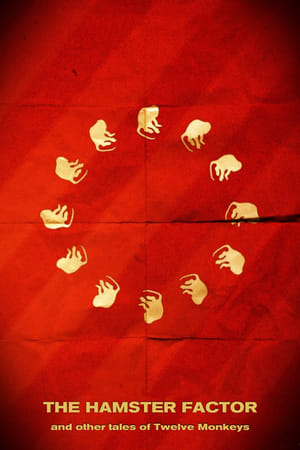 14. THE HAMSTER FACTOR AND OTHER TALES OF THE TWLEVE MONKEYS
14. THE HAMSTER FACTOR AND OTHER TALES OF THE TWLEVE MONKEYS
This 86-minute document on the making of Terry Gilliam’s TWELVE MONKEYS (1995), which was included as an extra on that film’s DVD, starts off looking like a standard “making of” promo, and in many ways that just what it is. The decidedly corrosive slant taken by its directors Keith Fulton and Louis Pepe is what sets it apart. We see Gilliam on set ranting and raving, arguing with star Bruce Willis and producer Charles Rovin, bitching that he can’t figure out the film’s story and at one point locking himself in his trailer. We also get a glimpse of the turmoil that erupts when the child actor cast in a pivotal role can’t hack it and Gilliam is forced to make a last minute casting change, while the crew is driven crazy by Gilliam’s insistence on focusing on tiny details at the expense of the larger picture, such as a hamster in the background of one scene (hence the title). Most intriguing of all, we get to look in on the test screening process, where randomly recruited audiences are herded into a screening of the film and then fill out cards detailing their responses—most of which, as you might guess, come up negative. For more fun from Fulton and Pepe, see their subsequent Gilliam-centered doco LOST IN LA MANCHA (2002), which outdoes this one in mirth and unblinking honesty.
13. THE ARCANE SORCERER (L’ARCANO INCANTATORE)
A suitably stately and atmospheric horror film from Italy’s Pupi Avati that was highly underrated in its day—and just as overrated now. Guillermo del Toro has called THE ARCANE SORCERER the “BARRY LYNDON of horror movies” due to sumptuous production design that evokes a 16th Century milieu where Giacomo (Stefano Dionisi), a demonically possessed seminary student, relates how he became the apprentice of the Arcane Sorcerer (Carlo Cecchi). This sorcerer, a former monsignor who was excommunicated for dabbling in sorcery, is looking to resurrect a deceased colleague through black magic, leading to ghostly visitations and the attention of an overzealous priest looking to take down the sorcerer. Deliberately paced and lacking in gore, the film often plays more like a dark period drama than a proper horror fest, albeit one with an atmosphere of profound ugliness and morbidity. The film also contains some truly rotten special effects, including a ridiculous Muppet bat featured prominently in one scene and a poorly animated “ghost” that figures in another. That latter depiction is especially unfortunate, as it ruins an otherwise impeccably executed scene of atmospheric horror. Yet Pupi Avati’s talent for evoking chills through subtle means is in full evidence throughout. A particularly inspired touch involves a ringing sound made by a finger moved around the rim of a wine glass—a ringing that continues after the finger is removed.
12. BOX OF MOONLIGHT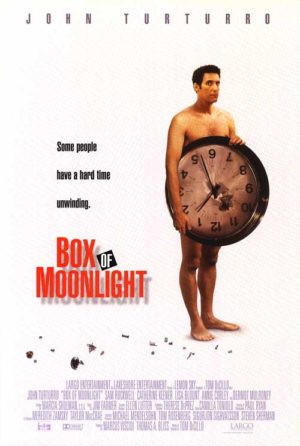
This terrific low-key comedy is representative of everything that was right about the indie film scene of the nineties (even though it didn’t make much money). In this tale of drudge John Turturro finding fulfillment in a country sojourn with weirdo Sam Rockwell, writer-director Tom DiCillo (of the previous year’s impressive LIVING IN OBLIVION) nails a distinctly American sense of quirkiness that quite a few other filmmakers have tried to attain but missed by a mile. A quiet, breezy, beautifully crafted little film that’s so good it’s difficult to believe the following year’s horrendous THE REAL BLONDE was made by the same guy.
11. THE BRIDE OF FRANK
The PINK FLAMINGOS of our time! This shot-on-video chunk of cheesola is cheap, trashy and disgusting–but also maniacally inspired and nearly impossible not to love. THE BRIDE OF FRANK‘S main character is Frank (Frank Meyer), a butt-ugly homeless man who does odd jobs for a bunch of sleazy guys who work for a New Jersey trucking company. The joke is that Frank and his situation are entirely real, as are the supporting players—but that’s where the “reality” ends. Frank in this film is a homicidal nut with a bad habit of brutally killing anyone who pisses him off. His victims include a small-time mobster who criticizes Frank for pissing in public and gets his wang bitten off for it (“Take that dick out of your mouth!” a co-worker scolds) and a nerd whose head Frank rips off—and then (literally) shits down his neck. There are also several women Frank interviews, hoping to find a sufficiently busty bride. They include a rude kung fu practitioner who gets a knife jammed through the bottom of her mouth, a trannie who gets parts of his face ripped off by Frank and a hoe who gets an eyeball ripped out. Yep, it’s that kind of movie! Much of it is pure cheapjack trash (it was shot on a VHS camcorder and edited with two VCRs), but it’s also consistently entertaining, with quite a few honest-to-goodness belly laughs.
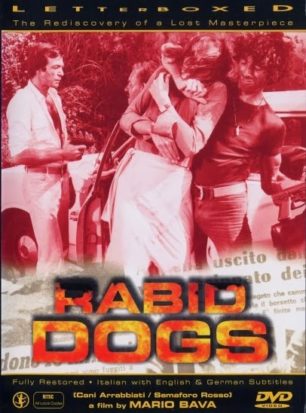 10. RABID DOGS (CANI ARRABBIATI)
10. RABID DOGS (CANI ARRABBIATI)
The toughest, grittiest, most nihilistic movie ever made by Italy’s legendary Mario Bava. RABID DOGS is a kidnapping drama totally different from the stylized and atmospheric horror fests from which Bava made his name (BLACK SUNDAY, THE WHIP AND THE BODY, BARON BLOOD, etc.). It works, though, and damn well, being the unforgettably minimalistic account of a man (Riccardo Cucciolla) racing a kid to the hospital (or so it appears) whose car is hijacked by three sociopathic criminals (Maurice Poli, Don Backy and Lujigi Montefiori), who force him drive them and an attractive female hostage (Lea Lander) to their country hideout. Thus we have six desperate people packed into a sweltering car on what looks like a VERY hot day. Among the obstacles the bad guys encounter are a nosy toll collector, the car running out of gas, the woman hostage’s escape attempt (she says she has to relieve herself and then tries to run off; her captors catch up to her and make her piss herself in front of them), a hitchhiking woman who picks the wrong vehicle to climb into and increasing infighting among the criminals, who aren’t as tight-knit as they initially seem. The project is first and foremost a moviemaking tour de force by Bava, who manages to sustain a remarkable amount of tension over the 96 minute running time in the most confined setting imaginable: a single car, where most of the action takes place. The film, incidentally, was never completed in Bava’s lifetime due to the unexpected death of one of its key investors. The footage was impounded until 1996, when it was pieced together and released to DVD. This explains why the film, despite its virtues, feels choppy and unpolished. A supposedly more definitive cut was prepared by the director’s son Lamberto, and released to DVD under the title KIDNAPPED. I much prefer the RABID DOGS version, which has a focus and intensity missing from KIDNAPPED and, flawed or not, is required viewing for any true horror/sleaze movie buff.
9. TIERRA (EARTH)
One of the most mind-boggling films of the decade! Let’s see: we’ve got an exterminator (Carmelo Gomez), sent to fumigate a rural community suffering from an outbreak of woodlice, who believes he’s part angel (perhaps because his name is Angel?). A voice from the cosmos tells Angel what to do, occasionally appearing beside him in the form of a double that only he can see. Is Angel nuts or is he indeed an angelic being? His dilemma is mirrored by two lovely ladies he’s attracted to, one a conservative married lass (Emma Suarez) and the other a leather-clad biker babe (Silke). Meanwhile, the woodlice continue to proliferate and lots of people in the area get struck by lightning. This visually stunning film was written and directed by Spain’s brilliant Julio Medem (LOVERS OF THE ARCTIC CIRCLE), one of the most distinctive filmmakers on the scene. I believe TIERRA is his masterpiece—after multiple viewings I still haven’t figured out everything that happens, but attempting to do so definitely seems worth the effort.
8. SAINT CLARA (CLARA HAKEDOSHA)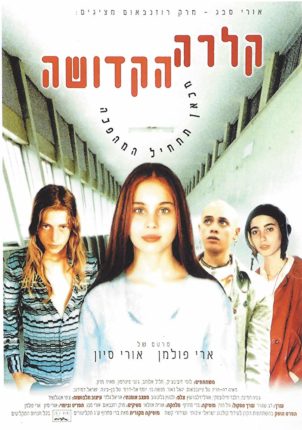
A totally unique film from Israel that has been accurately described as playing like a collaboration between John Hughes and David Lynch. Clara (Lucy Dudinchik) is a junior high schooler with psychic powers that enable her to predict test answers and create group hallucinations. The film’s matter-of-fact acceptance of Clara’s powers is one of the many things that make it such a refreshing delight. It seems that her parents both had similar “gifts,” which vanish once the subject falls in love. Unfortunately for Clara’s classmates and her school principal (Yigal Naor), all of whom want to use her for their own purposes, she’s about to fall for a long-haired thug (Halil Elohev) with a sensitive core. Aside from the startling visual style and skilled underage performers, I was especially impressed by the innovative use of music (which, incidentally, yielded an excellent soundtrack album by the Israeli rocker Barry Sakharov). The storytelling is a mite cluttered (it took me two viewings to sort out the plot), but with so much on view that’s so fine I’ll refrain from complaining too loudly.
7. NORMAL LIFE
A near-perfect based on fact film from HENRY: PORTRAIT OF A SERIAL KILLER’S John McNaughton, starring Luke Perry as a lonely cop and Ashley Judd as the schizophrenic hottie who destroys his life. Judd is a revelation, displaying copious nudity and an always-unpredictable personality. Her spendthrift lifestyle nearly bankrupts them both, until Perry, hopelessly in love with his loony wife, takes to robbing banks in order to support them. The lead performances simply couldn’t be bettered, while the film overall is relentlessly compelling in charting its protagonists’ agonizing descent into Hell.
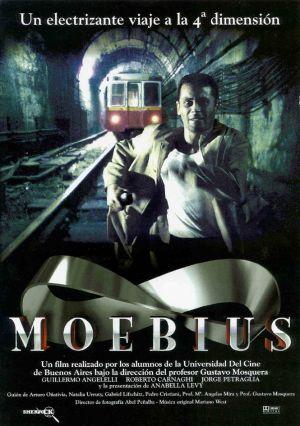 6. MOEBIUS
6. MOEBIUS
A challenging, stylish and eerie sci fi thriller from Argentine filmmaker Gustavo Mosquera, whose previous film was the impressive TIMES TO COME (1988). That film was visually breathtaking but a mite thin conceptually, while in MOEBIUS Mosquera manages to match his visual prowess with an intriguing TWILIGHT ZONE-ish story bearing some very real political overtones. A subway train carrying 30 passengers disappears one morning and the head engineer is called in to investigate, but sends a mathematically minded assistant (Daniel Pratt) in his place. The latter’s investigation takes him into the sphere of a mysterious designer, wherein he discovers the bizarre “secret” of the tunnels: there are so many of them, apparently, that an endless Mobius strip has been created that the train is caught upon, running in an endless loop. Of course, the subway officials would rather just forget the whole thing, reflecting the attitudes of modern-day Argentine authorities about the 30,000 plus political dissidents who “disappeared” in pre-democratic Argentina. Yet Mosquera never loses sight of the entertainment factor, and creates an absorbing and unpredictable piece of speculative delirium.
5. CONSPIRATORS OF PLEASURE (SPIKLENCI SLASTI)
A bizarre movie buff’s nirvana! From the brilliant Czech surrealist Jan Svankmajer comes CONSPIRATORS OF PLEASURE, a dialogue-free study of six apparently normal individuals engaged in obsessive quests to satisfy their various desires. The methods these closet pervs use to get off are definitely strange (that much goes without saying) and often insanely elaborate, as with the meticulously constructed chicken costume created by one determined role-player whose retinue also includes a marionette and a blood filled balloon. And who can forget the guy who builds robotic arms for his TV set to fondle him while his favorite newscaster is onscreen, but keeps getting stymied by commercial interruptions? As for the newscaster herself, she likes having fish suck her toes, but only after feeding ‘em tiny bread balls that the mailwoman has stuffed into her nose and ears. Amazing stuff, executed with Svankmajer’s usual mixture of live action and Claymation. My only complaint is that, with its scant 83 minute running time, this film isn’t longer!
4. THE LONG KISS GOODNIGHT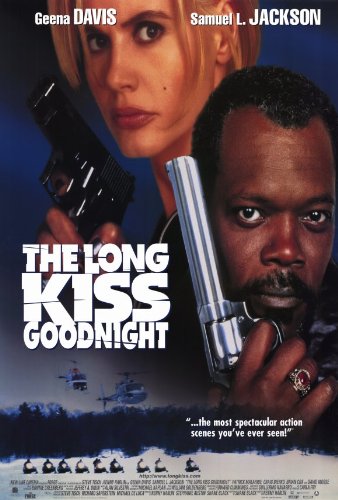
I really dig this unapologetically mindless, gleefully amoral, hyper-violent actioner with Geena Davis as a schoolteacher with amnesia who’s actually a government-appointed hit woman. The film was not a financial success, even though it was scripted by LETHAL WEAPON’S Shane Black. That script, which sold for a record $4 million back in 1994, followed Black’s equally hard-core LAST BOYSCOUT, one of my most beloved guilty pleasures. His dialogue is genuinely witty and relentlessly foul (even if the line “I’d eat a mile of her shit just to follow it back to the ass it came from” didn’t make it into the finished film), and the bloodletting extremely plentiful. Good work, also, from Samuel L. Jackson as Davis’s wiseass sidekick, who lends the proceedings a distinctly Quentin Tarantino-esque vibe (even though Black was doing this sort of thing long before QT came along). I tend to like my action movies served up hard, and in that sense THE LONG KISS GOODNIGHT, unlike so much of today’s wussified PG-13 fare, really satisfies.
3. SZAMANKA
Poland’s late Andrzej Zulawski was one of the world’s most interesting filmmakers, and this is one of his greatest films. With SZAMANKA Zulawski fully recaptured, and even surpassed, the rage and excess of his fabled 1979 masterpiece POSSESSION. The unspeakably deranged story involves a middle-aged architect (Boguslaw Linda) who discovers the preserved body of an ancient shaman, just as he gets involved with a free-spirited, and possibly schizophrenic, young woman (Iwona Petri). As Linda becomes more obsessed with the shaman corpse his relationship with Petri grows increasingly perverted, in plentiful soft-core sex scenes that are photographed and edited like wrestling matches. For that matter, the characters often behave like spastic gladiators. This is an unrestrained primal scream of a movie that deals only with extreme actions and emotions, and unreels with all the subtlety of a kick in the face. The eighteen-year-old Iwona Petri, whom Zulawski apparently discovered in a cafe, gives a sexy, demonic and amazingly unhinged (not to mention rarely clothed) performance. For a long time it was believed Petri had a nervous breakdown as a result of appearing in this movie; that claim has since been repudiated, so my question is, when is she going to appear in another?
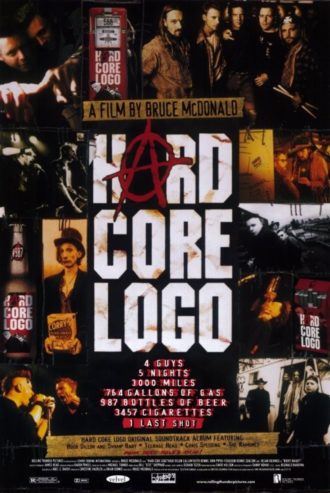 2. HARD CORE LOGO
2. HARD CORE LOGO
A mock-documentary by Canada’s Bruce McDonald, who, with ROADKILL, HIGHWAY 61, DANCE ME OUTSIDE and this masterwork, went from strength to strength in the nineties (a streak that unfortunately ended with the start of the ‘00s). Hard Core Logo is an entirely convincing Vancouver punk band reuniting for a last-ditch tour, having broken up back in ’91. Unfortunately, it quickly becomes evident that there was a damn good reason they split–these guys just can’t get along, and the old tensions flare up almost immediately. Add to that the standard pressures of touring, which the film does a superb job conveying, and you’ve got a disaster waiting to happen. McDonald’s filmmaking is gritty, kaleidoscopic and kinetic as Hell, and never shies away from the more unsavory aspects of the punk movement. At the film’s center is real-life punker Hugh Dillon as HCL’s headliner Joe Dick, who initially comes off like a grandstanding shitheel but by the end reveals himself to be a far more complex character. The same can be said for just about everyone else in the cast, populated by a perfectly chosen assortment of colorful faces.
1. CRASH
A great film adapted from the novel by J.G. Ballard, one of the most interesting writers on the planet, by David Cronenberg, one of the most interesting filmmakers on the planet. The result is much better than NAKED LUNCH, Cronenberg’s last attempt at translating the work of an “interesting” author to film. Ballard’s novel was a quasi-science fictional look at the birth of a none-too brave new world, ushered in by a group of perverts who get off on car crashes. Cronenberg removes the sci fi trappings, setting his film in the here-and-now (specifically his hometown of Toronto, Canada) to create a surreal look at modern man’s twisted relationship with technology. It’s a cold, creepy, impeccably crafted vision; not a shot is wasted, and the performances all hit the mark, particularly those of Elias Koteas and (especially) the mysterious and seductive (and vastly underrated) Deborah Kara Unger. Think of it as a new-wave porno flick, complete with countless soft-core sex scenes and nearly as many crashes.
